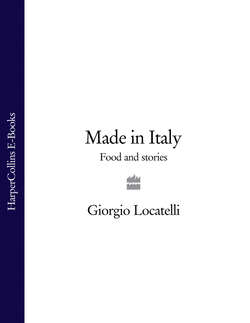Читать книгу Made in Italy: Food and Stories - Giorgio Locatelli - Страница 78
Pane Bread
ОглавлениеMy father goes seven kilometres to buy the bread every day. In our house, like most houses in Italy, bread is the first thing that goes on the table. It is such a big part of the meal – at one time, in poor families, it was the meal, supplemented by whatever else you had to hand.
When I was in Sicilia I learned a new expression, il conpanatico. I was out in the olive groves at the Planeta estate near Menfi, tasting the oils we buy from Alessio Planeta and his family, and they had some agricultural students from Roma working there. At about eleven o’clock, one of them asked, ‘Che cosa c’è per il conpanatico?‘ ‘What are you talking about?’ I asked them. Of course the word conpanatico must mean ‘with the bread’ – but I had never heard the expression before. In this area, they told me, bread is considered so important that you don’t ask ‘What is for lunch,’ but ‘What are we going to have with the bread?’
I thought it was a brilliant expression that really shows the way that Italians, like most Europeans, value bread. It is something that is difficult for many people in Britain to understand, because, despite there being a new wave of artisan bakeries and a big interest in different kinds of bread, the bestselling loaf is still the commercially made white square one that goes in the toaster, and is only eaten at breakfast time, or for sandwiches. When my father first came to London, it drove him crazy that if you went out to eat there was no bread on the table as soon as you sat down. He even asked for bread in a Chinese restaurant.
In Italy, people don’t bake at home that much, because they don’t need to. Virtually every village still has a bakery and every region has its own style of baking. In the very North, close to Austria, they make a lot of rye bread, and often use spices. In Lombardia, we still make castagnaccio, chestnut bread, which was a staple during the War, and pane de mais, made with polenta, but most of our breads are quite light, and like the French, we buy some every day.
In Toscana and further south you have the bigger breads. In Toscana they are also often unsalted, perhaps because they use a lot of salt in the local salami and prosciutto, which is traditionally eaten with it. In Sardegna they like to use semolina in their bread and they also have the wonderful crispy pane carasau, or carta di musica: thin, thin sheets that are so-called because they resemble music parchment paper, which you buy stacked up like Indian poppadoms, then sprinkle with olive oil and rosemary, and put into the oven for a few minutes to serve with olives and drinks before you eat.
It makes me laugh that one of the first Italian breads to become fashionable in Britain was the ciabatta, when at home it was originally the bread of the poor people. After the War, there was a shortage of grain, and white dough was considered to be the privilege of the rich, but when there were scraps of the dough left over, they were stretched into long ‘slipper’ shapes for everyone else.
The bread that really brings back nostalgic memories for me is the michetta (or rosetta), which is almost a symbol of Lombardia. When I used to go mushroom hunting with my granddad, we would go to the salumificio and buy the mortadella, and then to the baker for the panini (bread rolls), usually the michetta, then sit down on the wall and eat it. Michetta is the bread with ‘five faces’, which is made using a special stamp, a little like a rose (which is why it is also called rosetta) that is pressed down into the dough. When it goes into the oven, the air is forced into each of the five ‘faces’ or ‘petals’, which puff up until they are virtually hollow.
At Locanda we are very proud of our bread basket, because, when it comes to the table as soon as you sit down, with some long Parmesan grissini, it gives you a taste of what is to come. We have our own dedicated bakery area in the kitchen and always we are developing new breads. At Zafferano, and when we opened Locanda, we worked with our good friend Dan Lepard to create the kind of breads that we were looking for. Now we have our own baker, ‘little Federico’ Turri (as opposed to ‘big Federico’, our sous chef) who, like me, is from Lombardia and used to work at the Gnocchi bakery of my cousins in Gallarate.
Baking is a beautiful thing to do. The dough is soft and warm and gorgeous and the smell of the yeast is fantastic – but you need to have some patience, and when you work with dough constantly, you begin to learn to judge instinctively how to adapt your bread to the conditions of the kitchen, which can be different every day. So you might use more or less water, according to whether the kitchen is more dry or more humid, and when it is summer, and hotter, you see that the bread proves faster, so you might use less yeast the next time you bake.
However, the recipes that follow are some of our more straightforward ones, which you should be able to make successfully at home even if you haven’t made bread before – and, of course, you have the satisfaction of knowing that you are only putting pure ingredients into your bread to feed your family, and none of the commercial additives and ‘improvers’ that the big companies use in order that your bread can stay on the supermarket shelves for weeks.
